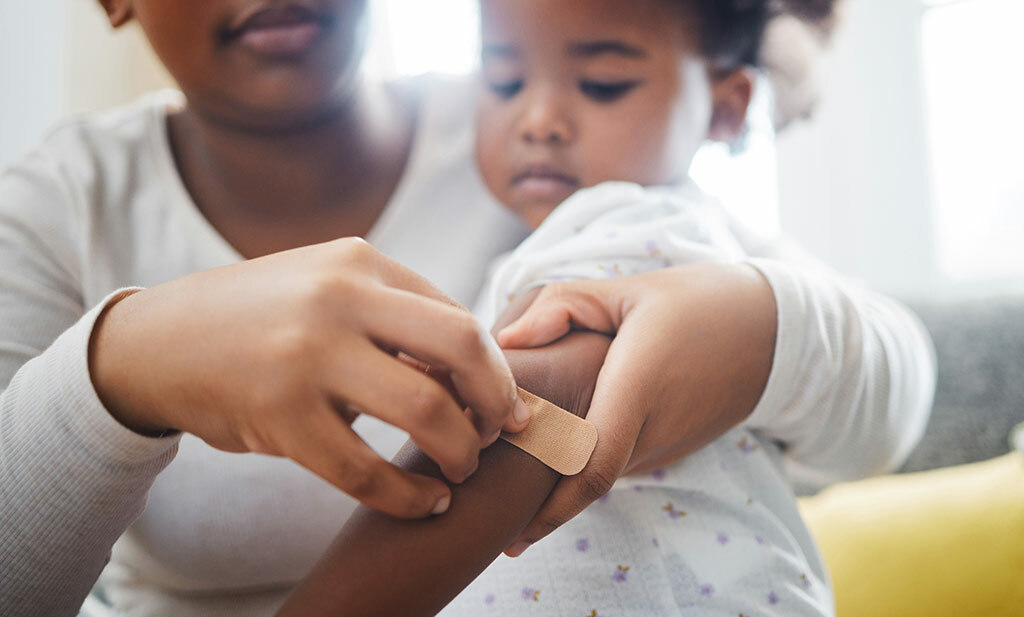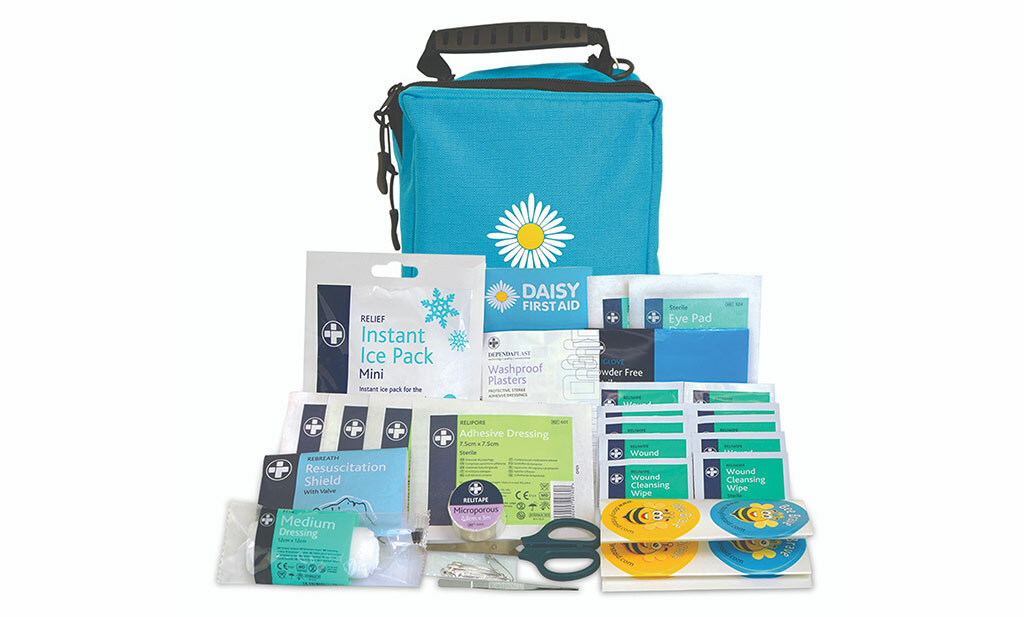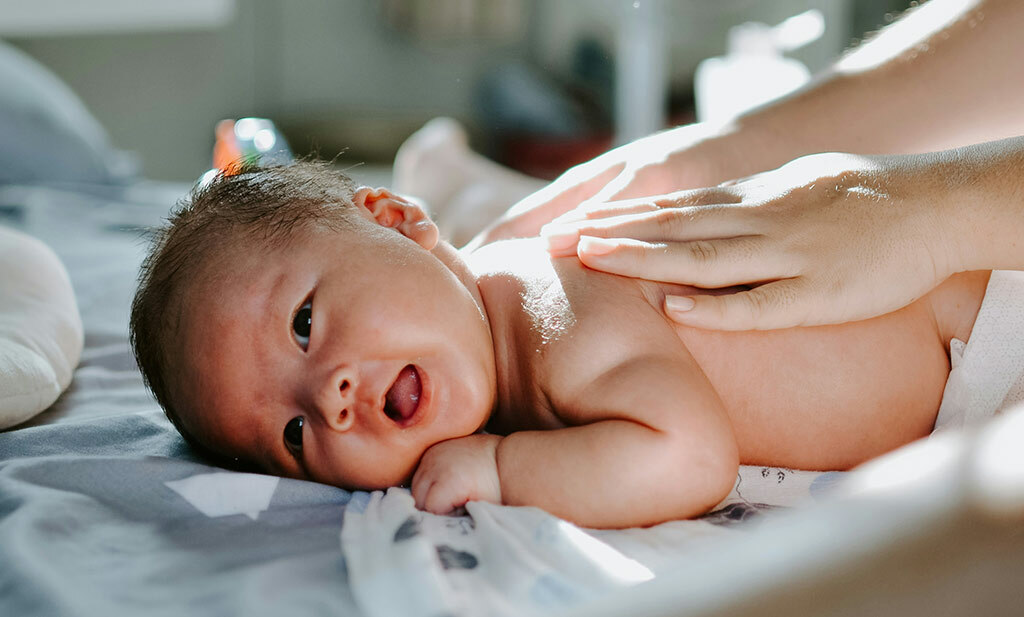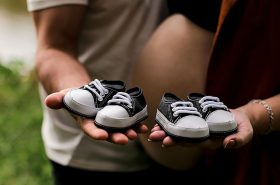
There is World First Aid Day every year on the second Saturday in September. Its mission? To provide everyone with an annual opportunity to promote and gain knowledge in first aid. So today we’re talking about “Baby First Aid” together with the experts from Daisy First Aid and Malteser – with basic information and tips for how to handle common childhood accidents and injuries.
They are some of the worst moments for parents: when baby rolls off the changing table or the bed, they have a high fever, they choke on a piece of fruit or are stung by a bee or wasp. Nobody wants those situations to happen, but they are unavoidable in everyday life with a baby. Our little ones are evolutionarily curious and want to discover the world.
They are also unable to assess many of the dangers in front of them as they haven’t got any similar experiences to draw from. And since accidents happen to everyone, it is important to distinguish between when a baby or toddler “only” needs comfort and when they need medical help.
No matter what the situation you’re facing, one thing is certain: it’s good to be able to keep calm in these moments. That way, you can ‘lend’ your child your sense of calm and security, as well as initiate any necessary help immediately. The surest way to ensure this is to complete a childhood or baby first aid course. They can help you be as prepared as possible should the worst happen.
Please note: This information has been compiled to the best of our knowledge and belief and with the utmost care. However, like any science, medicine is subject to constant developments. Every user of this information is required to check the individual case at hand and the information given here very carefully. The use of the measures mentioned here is at the user’s own risk.
First aid for babies and infants: the basics
If you and your baby have an emergency, try to stay as calm as you can. Your calmness will help them to stay calm and it will help you assess the situation and remember/figure out what you need to do. Next, depending on the situation you’re in, work through this checklist:
1. Life-threatening: yes or no?
It can be difficult to know when to call an ambulance. Call 999 if your child:
- is struggling for breath (for example, you may notice them breathing fast, panting, becoming very wheezy, or see the muscles just under their ribcage sucking in when they breathe in)
- is unconscious or seems unaware of what’s going on
- has a cut that will not stop bleeding or is gaping open
- will not wake up
- has a fit for the first time, even if they seem to recover
2. Make an emergency call: 999 or 112 (European emergency number)
If any of the above are true or you are worried about your baby’s condition then don’t hesitate to call 999 to reach the emergency services, who are always there to help and advise you. If in doubt, it’s always better to call the emergency services once too often than once too little. The following information is important:
- WHO is calling?
- WHAT has happened?
- WHERE is help needed?
- WHO is affected? How many children are affected and how old are they?
- WHAT injuries do they have?
Be sure to wait for further questions and do not hang up. They will give you instructions over the phone, sometimes over multiple calls, on what to do until the emergency services arrive.
3. Recovery position:
If your baby or infant is unconscious AND breathing: place them in the recovery position. To do this, cradle the baby in your arms, with their head tilted downwards to prevent them from choking or inhaling vomit. For an older child you place them in the same position as adults.
4. Cardiopulmonary resuscitation (CPR):
If your child is no longer breathing, you must perform rescue breaths and chest compressions with artificial respiration and blood circulation. It’s vital to learn exactly how to do CPR for babies and infants on a specialised baby first aid course. Even if it will hopefully never happen, this measure can save your baby’s life in emergencies such as respiratory arrest or cardiac arrest. Important: This is performed differently depending on the age of the child and the child’s lungs cannot absorb as much oxygen. Babies are only resuscitated with two fingers on the lower sternum, the head is not tipped back and ventilation is performed via both the mouth and nose.
5. Baby first aid kit:
If you are travelling with your baby, you should always have a baby first aid kit to hand. Some useful things to include:
- dressing material such as sterile compresses, bandages and plasters in various sizes
- scissors
- ice/heat packs
- triangular cloth
- rescue blanket
- digital thermometer
- saline solution for cleaning wounds
- tick and splinter tweezers
- disposable gloves
- disinfectant wipes
- hand sanitiser
- wound spray
Check the contents regularly for completeness and shelf life. By the way: Water is also part of first aid for babies and infants. You can use it to clean wounds, cool burns or stings, wash hands, remove sand from eyes and much more. So: always have a bottle to hand.

6. Important emergency numbers:
As well as knowing the number/s for emergency services (999), it’s also helpful to keep a list of all the other numbers you might need. NHS 111 is a great service for when it isn’t an emergency but you think you or your child need medical help. Other useful numbers to keep to hand are the number of the regional poison control centre, your GP’s out of hours number, and the address of the nearest hospital. Keep this list somewhere easy to see, e.g. on the fridge or a noticeboard. This also applies when you go on holiday, you should always know who you can contact in an emergency.
7. Is your child showing symptoms after a delay?
In life-threatening situations, call 999, otherwise go to urgent care or a hospital and have the symptoms clarified.
Baby first aid: Some common childhood accidents and injuries
Obviously, we can’t go into all the possible emergencies you might face with your child in one blog post so we highly recommend attending a baby first aid course! In the meantime, here are a few of the most common scenarios you might find yourself in, and tips on what to do.
1. First aid for choking and suffocation
Babies and toddlers can easily choke on small objects like coins or marbles found on the floor, or of course food. If it happens then encourage your child to cough and keep a close eye on whether they are breathing effectively. If the object is too big, it can get stuck in the oesophagus and cause injury. It becomes even more critical if your baby has inhaled the foreign object and can no longer breathe normally. You can recognise this, for example, by breathing difficulties, a persistent urge to cough, whistling noises when breathing and a discoloured face, and the baby or child would become silent. They could can turn red or blue because breathing has stopped. Call 999 immediately and initiate first aid measures.
For babies who are only a few months old and cannot yet stand on their own, you should do the following until the emergency services arrive:
- Sit on a chair with your legs close together and place the baby on its stomach on your thighs. The chest rests on your knees with their head lower than their bottom.
- Firmly hit the middle of their shoulder blades up to five times.
- If this does not dislodge the blockage , turn your baby over and place two fingers in the middle of their chest just below their nipples. Push sharply downwards up to five times .
- If there’s still no improvement, repeat the thrusts until the emergency services arrive.
Important: Even if baby coughs and can breathe again, the foreign body may have fallen into a lung so they must still be examined by a doctor. For older children, the same rules apply as for adults who have choked.
2. First aid for sunstroke and heatstroke
As we all know, babies and children are much more sensitive to the sun’s rays and summer heat than adults, as they are not yet able to regulate their temperature as well and babies’ delicate skin is much more sensitive. Protect your baby from sunlight and stay in the shade as much as possible in the early years. Also avoid waiting in / driving in a car that is too warm. If sunstroke does occur, it can cause headaches, dizziness, nausea and a rapid pulse. However, the situation becomes even more dramatic in the event of heatstroke: this causes a rise in temperature (more than 40 degrees Celsius) with a very red face, altered consciousness and possibly chills and a stiff neck. If this happens:
- Call an ambulance immediately and take your baby to a cool, shady place.
- Remove thick clothing immediately.
- Place damp cloths over baby’s body to carefully cool them down (caution: do not use ice-cold water!)
- Give them their usual milk or water (not too cold), depending on age.

3. First aid for insect bites
Everyone is familiar with insect bites, especially in summer. They are unpleasant, but as long as there is no allergy, they are usually harmless. A warm flannel on the sting site can destroy the venom of the bee or wasp. After a few minutes, cool the area.
Be careful, however, if you have difficulty breathing, wheals on the skin, an increased pulse, fever, nausea and chills. This may be an allergic shock.
- Call an ambulance immediately.
- Loosen tight clothing.
- Depending on the condition: Put your child in an upright/sitting position or lay them down and put their legs up – if unconscious but breathing, place them in the recovery position.
- If breathing or cardiac arrest occurs, resuscitation must be started immediately.
- In the case of ticks: Remove the tick with special pliers/tweezers or a tick card and consult a doctor if you notice a rash or become unwell.
4. First Aid for Febrile Seizures
A febrile seizure is a type of seizure caused by a spike in body temperature. There is a part of the brain called the hypothalamus, which is responsible for temperature regulation and this part of the brain isn’t fully developed until a child turns around 4 or 5 years old. In some children, when their temperature increases it can trigger a seizure.
They are most common in children aged between 6 months and 3 years but they can happen in older children and younger babies. Some children will experience them regularly, some will have one and never have another one and some children will never experience them.
During a febrile seizure your baby or child may become very stiff and their arms and legs may begin to twitch, lose consciousness and may lose control of their bladder or bowels, they may start foaming at the mouth (which sounds very frightening but the saliva has nowhere to go so that’s why it happens), there may be blood in the saliva if the child has teeth and has bitten the inside of their cheek or their tongue, their lips might start to go a bit blue and their eyes may roll back in their head.
A febrile seizure usually lasts for a couple of minutes. There’s nothing you can do to stop the seizure from happening and it’s not recommended to pick children up while they are having a seizure. Here’s what you should do:
- Call 999
- Protect their head
- Time the seizure
- Once they have stopped having the seizure put them into the recovery position while you wait for help to arrive.
- You can also begin to cool them down gently by getting air circulating around the room and removing layers of clothing.
It’s important to remember that they are usually harmless and almost all children make a full recovery afterwards.
First aid for babies and infants – knowledge helps
Keeping a cool head and not panicking is crucial if your baby is injured or you’re in an emergency situation. And it helps if you know what to do. We hope this post has given you a few baby first aid basics but we never tire of emphasising how important it is that you attend a first aid course specially designed for babies, infants and toddlers. After all, in addition to the situations we covered above there are many other situations in which first aid is necessary. So, what are you waiting for? Find a first aid course and book it. You’re doing it for yourself and for your children!
———————–
Sources:



